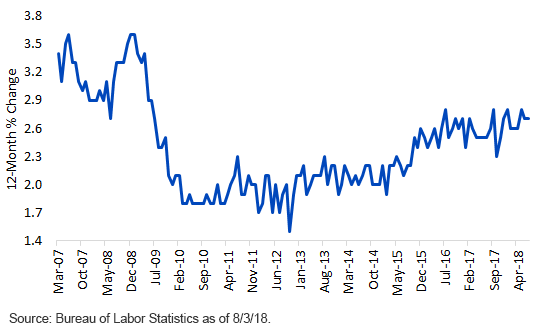Stuck in a Moment and You Can’t Get Out of It


The labor market backdrop in the U.S. continues to remain on solid footing. However, there is still a recurring theme that investors have been observing when they examine the monthly employment report: robust job growth with a lack of forward momentum for wages.
In terms of job creation, there is an ascending trajectory to be witnessed thus far in 2018. Through July, total nonfarm payrolls have been producing a monthly average increase of 215,000 versus last year’s rise of 182,000. In fact, this year’s performance so far ranks as the best in three years. Needless to say, higher levels of employment have pushed down the jobless rate in the process. According to the latest data from the Bureau of Labor Statistics, the jobless rate has fallen to 3.9%, a -.4 percentage point decline from the year-ago level of 4.3%. In fact, in three out of the last four months, the unemployment rate has come in with a “3” handle, a run that hasn’t been seen in almost 18 years.
Average Hourly Earnings

These two aforementioned developments should bode well for the consumer outlook. However, wages continue to be the “fly in the ointment.” Average hourly earnings (AHE) rose at an annual rate of 2.7% in July, matching the prior month’s reading and identical to the 2017 year-end observation. The accompanying graph clearly illustrates how annualized wage gains really have been stuck in a rather narrow range over the last few years. That band has only gotten tighter in 2018, as the AHE range has come in between 2.6% and 2.8%.
Back to the consumer spending outlook. Besides the favorable trends for new job creation and unemployment, tax cuts can also act as a tailwind going forward. It is important to note, though, that the potential positive impact from lower taxes does not necessarily translate into a “longer-run” positive factor. To be sure, one could argue that tax cuts provide stimulus more in the short-run—i.e., the year in which they are enacted and actually affect household balance sheets. To push consumer spending, and by extension economic growth, to the next level, an increased pace of wage gains would need to become part of the mix. Thus far in 2018, personal consumption expenditures have grown by an average rate of 2.3%, or not too far removed from the 2016/2017 pace.
Conclusion
What does this all mean for U.S. interest rates? In terms of the Federal Reserve, not all that much. The Federal Open Market Committee’s views on the overall economic and labor force backdrops continue to point toward “further gradual increases” in the Federal Funds Rate going forward. With respect to the U.S. Treasury market, the 10-Year note yield seems to be concentrated more toward the upper-middle part of our 2.50% to 3.25% trading range when the focus is solely on incoming economic data. For fixed income investors, we continue to advocate a core approach, complemented by rate-hedging strategies.
Unless otherwise noted, data source is Bloomberg as of August 3, 2018.


